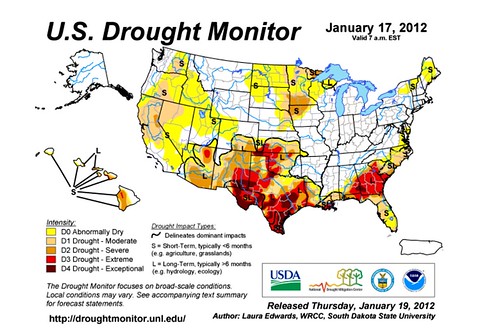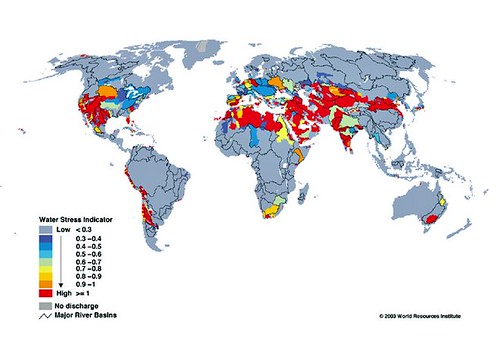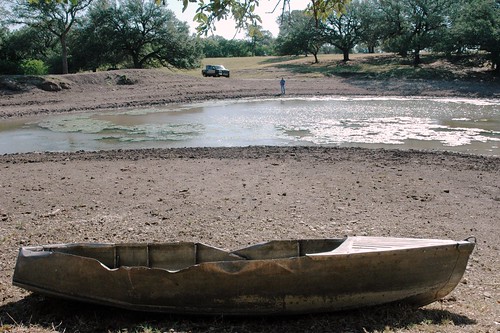Reconciling cities with water scarcity

Posted January 23, 2012 at 1:29PM
When you look at the official US drought monitor map, you immediately see that many American cities may be in the wrong places for long-term water sustainability. In particullar, note the presence of “long-term,” severe-to-extreme drought conditions across most of Georgia, Texas, Oklahoma, New Mexico, and Arizona.
It’s a very sobering set of facts, especially when you consider that essentially every high-growth part of the US is experiencing significant dryness. Now let’s look at a second map, this time world-wide:
This is not just a US Sun Belt problem but a major international problem. Here are a few facts and projections extracted from a very good summary of the issues by Jay Kimball on his blog 8020 Vision:
- By 2020, California will face a shortfall of fresh water as great as the amount that all of its cities and towns together are consuming today.
- By 2025, 1.8 billion people will live in conditions of absolute
water scarcity, and 65 percent of the world’s population will be water stressed.
- In the US, 21 percent of agricultural irrigation is achieved by pumping groundwater at rates that exceed the water supplies ability to recharge.
- There are 66 golf courses in Palm Springs. On average, they each consume over a million gallons of water per day.
- The Ogalala aquifer, which stretches across 8 states and accounts for 40 percent of water used in Texas, will decline in volume by a staggering 52 percent between 2010 and 2060.
- Texans are probably pumping the Ogallala at about six times the rate of recharge.
With increasing rises in the temperature of the earth’s surface and atmosphere, this problem seems only likely to get worse. The geographic details may shift from one season to another, but the long-range trend is toward further diminishing of our sources of water. A major problem with so many environmental issues, including this one, is that the damage occurs slowly, so that people are lulled into gradually accepting additional increments of deteriorating conditions without alarm. But that doesn't change the facts.
Looking at the US, we’re not realistically going to shut down the whole state of Texas, along with Atlanta, Oklahoma City, Albuquerque and Phoenix. We’re not going to stop those places from growing, either, pipe dreams of some ardent environmentalists aside. (Nor are we going to shut down North Africa, every country bordering the Mediterranean, India, and large parts of China.)
So, what to do?
This is not going to be a post that pretends to have all the answers, many of which are going to have to come from agriculture, which is outside my expertise. But I’ll offer a few thoughts about some answers that must also come from how we grow our cities.
For example, a decade ago, my colleague Deron Lovaas co-authored a report demonstrating how the spread of pavement caused by suburban sprawl prevents water from recharging underground reserves. From a summary released by NRDC with its research partners American Rivers and Smart Growth America:
“In Atlanta, the nation's most rapidly sprawling metropolitan area, recent sprawl development sends an additional 57 billion to 133 billion gallons of polluted runoff into streams and rivers each year. This water would have otherwise filtered through the soil to recharge aquifers and provide underground flows to rivers, streams and lakes.”
EPA research shows that building 1000 new homes in a watershed at an average density of eight units per acre instead of four units per acre could save as much as 27 million cubic feet of runoff per year in a typical watershed. (Building at eight units per acre instead of one unit per acre could save 137 cubic feet of runoff per year.)
Greater average density also means less irrigated urban land per household.
In addition, I’ve been arguing for some time that “green buildings” aren’t really green if they contribute to sprawl, and that “smart growth” isn’t really smart unless it includes green buildings and infrastructure. Doesn’t the presence of long-term drought conditions argue even more strongly for the notion that smart growth should include water-efficient technology and green infrastructure to filter rainwater before it becomes runoff?
Finally, could this be another argument in favor of reviving, rather than abandoning, our Rust Belt cities in order to take growth pressure off the Sun Belt?
Move your cursor over the images for credit information.
Please also visit NRDC’s Sustainable Communities Video Channel.



